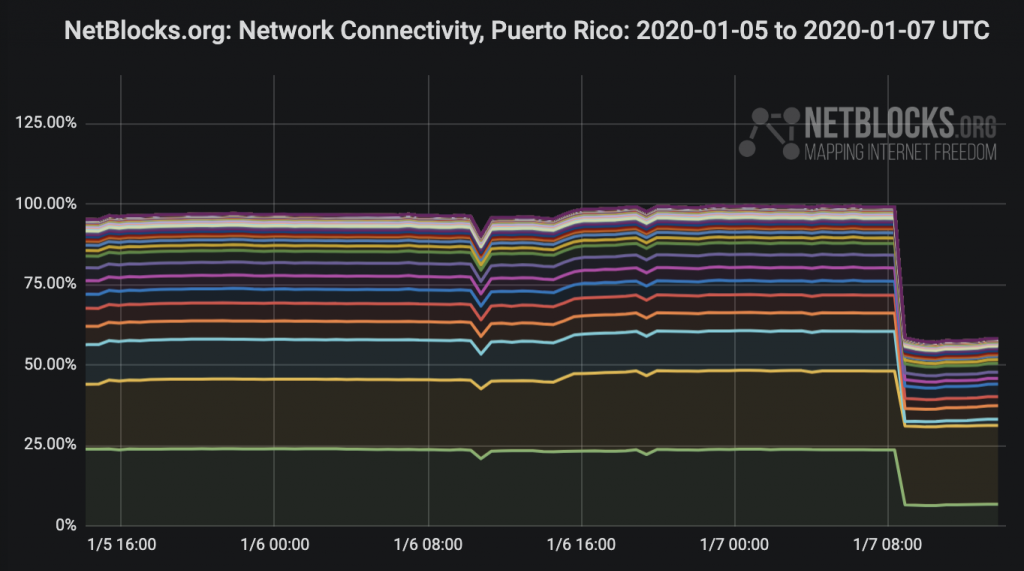Network data from the NetBlocks internet observatory confirm significant impact to the island’s fixed-line networks after an earthquake struck south of Puerto Rico early Tuesday 7 January 2020 at 4:24 a.m. local time (08:24 UTC). Disruptions continue some six hours after the incident first registered.
National connectivity fell to 60% of ordinary levels amid power cuts as the 6.4 magnitude earthquake struck, however the resilience of Puerto Rico’s cellular networks has allowed residents to remain largely online as they address the crisis.
Update: Internet access in #PuertoRico gradually recovering two days after a 6.4 magnitude earthquake knocked out the island's power impacting telecoms infrastructure; real-time network data show national connectivity now up to 75% of ordinary levels ?
?https://t.co/IfjXjM9IYe pic.twitter.com/Iylww0ddx8
— NetBlocks (@netblocks) January 9, 2020
Norberto Cruz Córdova, president of Internet Society Puerto Rico explains, “We’re experiencing seismic moves since 28th of December which have being increasing in last 2 days with a 6.4 earthquake this morning. Currently, there’s a major energy blackout in the island but telecom systems are up and the citizens are communicating via cellphones. At this moment the Internet is up.”

Network data show a fall in connectivity across most autonomous networks registered to Puerto Rico at the same time the earthquake struck, 4:24 a.m. local time (08:24 UTC). Readings suggest indicate the outage is strongly correlated to the failure of power supply. This is reflected in outages to broadband networks and technical infrastructure while impact is less evident when it comes to international traffic.
Earthquakes and internet connectivity
Earthquakes and tremors can have impact on data transit as well as the edge of the network for a variety of reasons. Puerto Rico’s internet disruption is closely tied to the major power failure.
Although disruptions are typically associated with fixed-line connectivity in these scenarios, the assumption is not universal. In September 2019, NetBlocks tracked a partial internet disruption in Turkey caused by a 5.7 magnitude earthquake which primarily affected mobile networks:
Confirmed: Significant outages affecting mobile and fixed networks in #Turkey from 11:00 a.m. UTC (2:00 p.m. local time) caused by magnitude 5.7 earthquake; internet and telecoms disruptions ongoing ? #Istanbul #Silivri #deprem pic.twitter.com/VmyCDMwE0Q
— NetBlocks (@netblocks) September 26, 2019
Methodology
NetBlocks diffscans, which map the IP address space of a country in real time, show internet connectivity levels and corresponding outages. Purposeful internet outages may have a distinct network pattern used by NetBlocks to determine and attribute the root cause of an outage, a process known as attribution which follows detection and classification stages.
A summary of data visualizations used in this report:
- Network Connectivity (National): All major internet providers and networks serving the affected region are visualized in a stacked time-series chart to identify the start and end times of an internet outage event. Scales on the y-axis are adjusted to match localized maxima while minima are scaled to 0 indicate periods when networks became unreachable. The x-axis represents Universal Coordinated time (GMT+0). Connectivity levels on the y-axis correspond directly to the observed number of reachable connections, as with National Connectivity charts.
NetBlocks is an internet monitor working at the intersection of digital rights, cyber-security and internet governance. Independent and non-partisan, NetBlocks strives to deliver a fair and inclusive digital future for all.
[ press | contact ] Graphics and visualizations are provided for fair use in unaltered form reflecting the meaning and intent in which they were published, with clear credit and source attribution to NetBlocks. Intellectual property rights are protected including but not limited to key findings, facts and figures, trademarks, copyrights, and original reporting, are held by NetBlocks. Citation and source attribution are required at the point of use.
